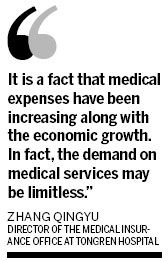Aging population puts pressure on insurance fund
Updated: 2013-02-18 08:02
By Wang Qingyun (China Daily)
|
||||||||
|
An elderly patient receives a shot to prevent infection at Beijing Tongren Hospital on Feb 9. Wang Shen / Xinhua |

With people living longer and a higher incidence of chronic diseases, the demand for medical services has been soaring in Beijing, putting growing pressure on the city's health insurance fund.
"It is a fact that medical expenses have been increasing along with the economic growth. In fact, the demand on medical services may be limitless," said Zhang Qingyu, director of the medical insurance office at Tongren Hospital.
Tongren is one of 33 hospitals in the city that now operate within a budget set by the fund, according to an official with the Beijing Municipal Bureau of Human Resources and Social Security.
The program started in July 2011, when four large public hospitals - Friendship, Chao-yang, Tongren and Jishuitan - began to receive fixed grants from the city's health insurance fund.
Previously, the fund would cover all refundable medical services provided by a hospital, no matter how expensive the total cost might be, said the official, who declined to be named.
But with the budget allocated by the city's health insurance fund, hospitals now have to pay if they go over budget, making it essential for them to control costs.
"Otherwise, they will need to pay 8 percent of the deficit," the official said.
This has spurred the hospitals to actively take charge of their costs, by introducing measures such as stricter controls on prescriptions.
Each hospital's budget was based on its premium over the previous three years, with a margin for possible increase of expenditure.
"The budget we received for 2012 was 10 percent more than the public health insurance premium we spent in 2011," said Zhang, who estimated that the premium has increased by an annual rate of 10 percent over the past few years.
By the end of 2012, Tongren Hospital had a 10 million yuan ($1.58 million) surplus, which accounted for about 2 percent of its budget.
Although setting the budgets in this way is not without its drawbacks, Gong Sen, a researcher at the Development Research Center of the State Council, China's cabinet, believes that the budgets have more advantages than risks.
"All methods of payment are flawed, the most prominent problem right now is hospitals providing excessive medical services," he said.
But he cautioned that there are some risks that need to be kept in check, such as when a hospital fails to use the budget right and then tries to stay within the budget by cutting down on the provision of basic services at the end of the year. Or when a hospital tries to make up for the reduced profits resulting from the stricter budget control by overcharging patients not covered by the capital's health insurance, such as those coming to seek medical treatment in the city from other provinces, for whom it's hard to get reimbursement back in their hometown.
However, these risks can be avoided, or at least reduced to a minimum, by using the city's information systems: The health authorities can check the specific data of public hospitals, such as changes in medical costs for both insured and uninsured patients throughout different periods, to detect and prevent possible adverse impacts.
wangqingyun@chinadaily.com.cn
(China Daily 02/18/2013 page4)

 In Photos: 7.0-magnitude quake hits Sichuan
In Photos: 7.0-magnitude quake hits Sichuan
 Li Na on Time cover, makes influential 100 list
Li Na on Time cover, makes influential 100 list
 FBI releases photos of 2 Boston bombings suspects
FBI releases photos of 2 Boston bombings suspects
 World's wackiest hairstyles
World's wackiest hairstyles
 Sandstorms strike Northwest China
Sandstorms strike Northwest China
 Never-seen photos of Madonna on display
Never-seen photos of Madonna on display
 H7N9 outbreak linked to waterfowl migration
H7N9 outbreak linked to waterfowl migration
 Dozens feared dead in Texas plant blast
Dozens feared dead in Texas plant blast
Most Viewed
Editor's Picks

|

|

|

|

|

|
Today's Top News
Live report: 7.0-magnitude quake hits Sichuan, heavy casualties feared
Boston suspect cornered on boat
Cross-talk artist helps to spread the word
'Green' awareness levels drop in Beijing
Palace Museum spruces up
First couple on Time's list of most influential
H7N9 flu transmission studied
Trading channels 'need to broaden'
US Weekly

|

|








